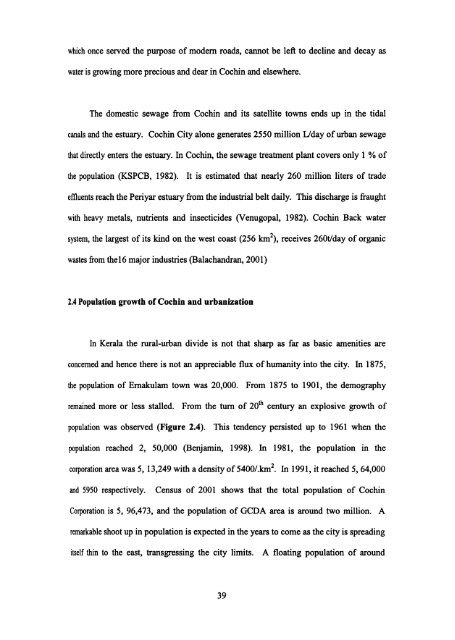Salinity Intrusion and Seasonal Water Quality Variations in the Tidal ...
Salinity Intrusion and Seasonal Water Quality Variations in the Tidal ...
Salinity Intrusion and Seasonal Water Quality Variations in the Tidal ...
You also want an ePaper? Increase the reach of your titles
YUMPU automatically turns print PDFs into web optimized ePapers that Google loves.
which once served <strong>the</strong> purpose of modem roads, cannot be left to decl<strong>in</strong>e <strong>and</strong> decay as<br />
water is grow<strong>in</strong>g more precious <strong>and</strong> dear <strong>in</strong> Coch<strong>in</strong> <strong>and</strong> elsewhere.<br />
The domestic sewage from Coch<strong>in</strong> <strong>and</strong> its satellite towns ends up <strong>in</strong> <strong>the</strong> tidal<br />
canals <strong>and</strong> <strong>the</strong> estuary. Coch<strong>in</strong> City alone generates 2550 million Uday ofurban sewage<br />
that directly enters <strong>the</strong> estuary. In Coch<strong>in</strong>, <strong>the</strong> sewage treatment plant covers only 1 % of<br />
<strong>the</strong> population (KSPCB, 1982). It is estimated that nearly 260 million liters of trade<br />
effluents reach <strong>the</strong> Periyar estuary from <strong>the</strong> <strong>in</strong>dustrial belt daily. This discharge is fraught<br />
with heavy metals, nutrients <strong>and</strong> <strong>in</strong>secticides (Venugopal, 1982). Coch<strong>in</strong> Back water<br />
system, <strong>the</strong> largest of its k<strong>in</strong>d on <strong>the</strong> west coast (256 knr'), receives 260t/day of organic<br />
wastes from<strong>the</strong>16 major <strong>in</strong>dustries (Balach<strong>and</strong>ran, 2001)<br />
2.4 Population growth ofCoch<strong>in</strong> <strong>and</strong> urbanization<br />
In Kerala <strong>the</strong> rural-urban divide is not that sharp as far as basic amenities are<br />
concerned <strong>and</strong> hence <strong>the</strong>re is not an appreciable flux ofhumanity <strong>in</strong>to <strong>the</strong> city. In 1875,<br />
<strong>the</strong> population of Emakulam town was 20,000. From 1875 to 1901, <strong>the</strong> demography<br />
rema<strong>in</strong>ed more or less stalled. From <strong>the</strong> turn of 20 th century an explosive growth of<br />
population was observed (Figure 2.4). This tendency persisted up to 1961 when <strong>the</strong><br />
population reached 2, 50,000 (Benjam<strong>in</strong>, 1998). In 1981, <strong>the</strong> population <strong>in</strong> <strong>the</strong><br />
corporation area was 5, 13,249 with a density of5400/.km 2 • In 1991, it reached 5, 64,000<br />
<strong>and</strong> 5950 respectively. Census of 2001 shows that <strong>the</strong> total population of Coch<strong>in</strong><br />
Corporation is 5, 96,473, <strong>and</strong> <strong>the</strong> population of GCDA area is around two million. A<br />
remarkable shoot up <strong>in</strong> population is expected <strong>in</strong> <strong>the</strong> years to come as <strong>the</strong> city is spread<strong>in</strong>g<br />
itself th<strong>in</strong> to <strong>the</strong> east, transgress<strong>in</strong>g <strong>the</strong> city limits. A float<strong>in</strong>g population of around<br />
39

















